How to Set Up Google Search Console
You absolutely must verify your Google Search Console ownership after creating your website if you want to thrive in the competitive realm of SEO. While you don’t have to verify your website in GSC to show up in search results, doing so grants you access to all the important data provided by the tool.
Google Search Console is an invaluable tool for webmasters, enabling them to identify site errors, ensure proper indexing of web pages, assess mobile-friendliness, gain insights into the search queries people used to find their site, and much more.
And today, our goal is to tell you how to set up Google Search Console right.
Get a free ebook that analyzes AIOs behavior before and after rollout
Click the confirmation link we sent to your you email
How to add your site to Google Search Console
To add your website to GSC and verify your ownership, you need to sign in to your Google Search Console account, choose one of the suggested property types, and use one of the five available options to prove that you own your website:
- Domain name provider
- HTML tag
- HTML file
- Google Analytics tracking code
- Google Tag Manager container snippet
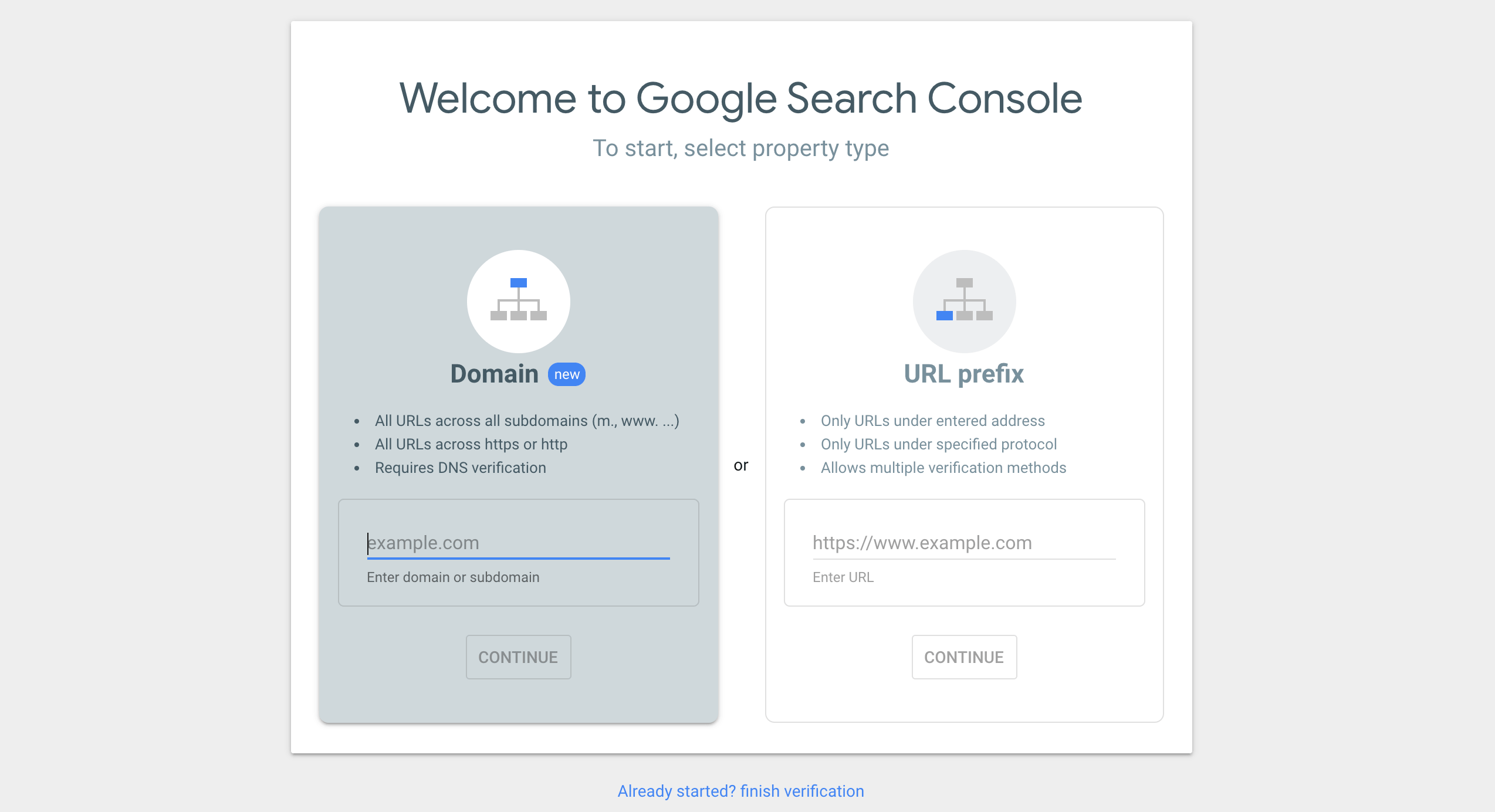
Domain property in Search Console
After adding a new property, you will have to choose a property type. GSC accepts two main website property types: URL-prefix property and Domain property. Unlike the URL-prefix property, which supports several verification types, the latter stands for DNS record verification only. A domain property includes all subdomains such as m, www, and multiple protocols: http, https, FTP.
The DNS method is considered one of the best ways to verify your website because it eliminates the need for re-verification if you decide to switch between using www and non-www in the future. See this article on www vs non-www choice to learn how www impacts SEO and your site’s technical setup.
Verifying via your domain name provider
A Domain property URL does not contain an http/https protocol and ignores www (if you add www.website.com, the property will be created as website.com). It also covers all subdomains and subpaths. For example, if a Domain property is website.com, then besides the domain name, the data includes the following subdomains:
- support.m.example.com
- m.example.com
To perform the Google Search Console setup through the DNS record, you must:
- Select the domain property type in Search Console.
- Choose your DNS provider from the DNS Providers list. For example, if your provider is Gandi.net, choose it and click Start Verification. Log in to Gandi.net, and click Authorize. From here, verification should occur immediately.
If your Search Console doesn’t show your domain name provider, or if it shows one that’s not yours, you’ll have to add it manually. Here’s how:
- Choose the record type. GSC offers two options: TXT and CNAME.
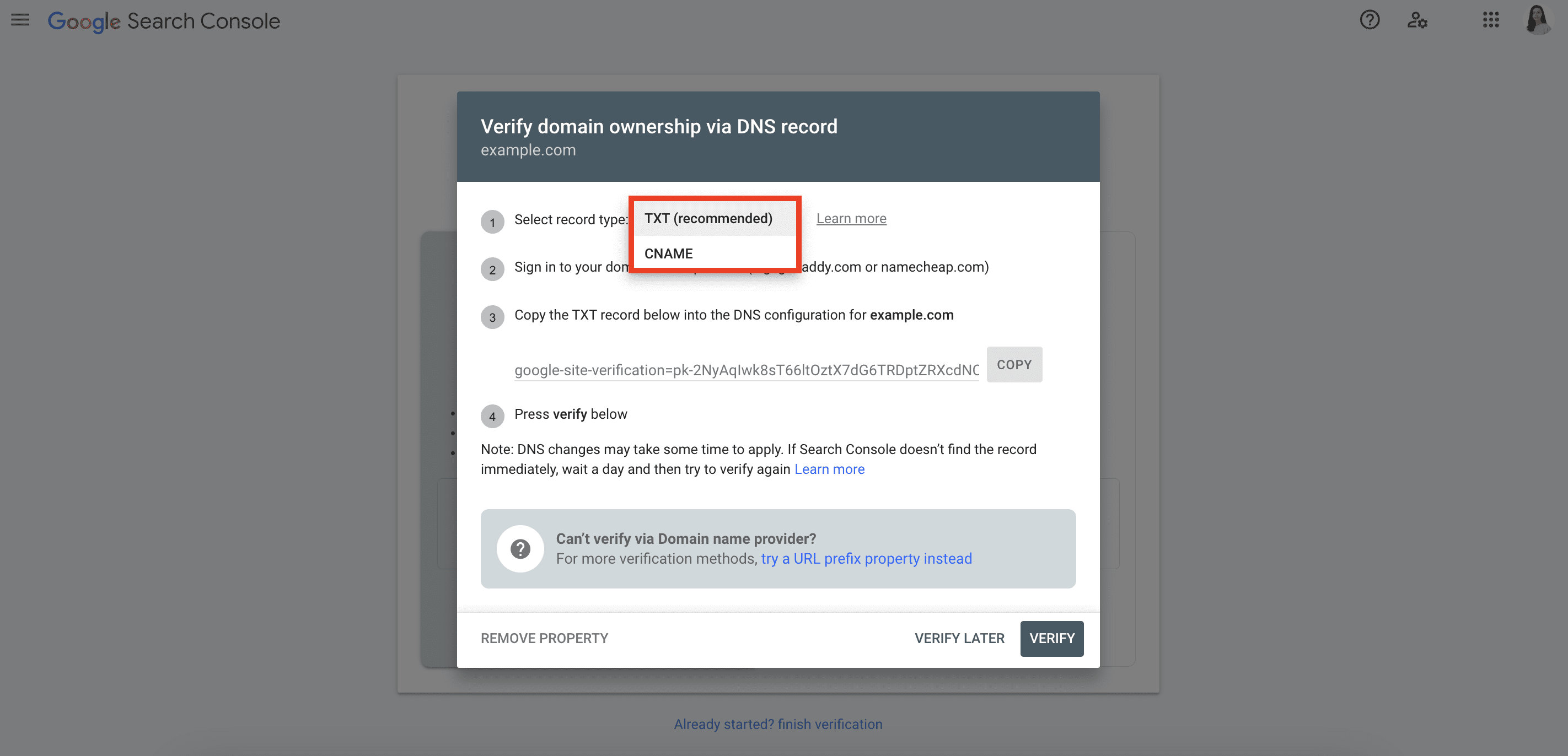
To determine which type to select, enter your domain name into the Google Admin Toolbox under the CNAME tab and observe the output. If the verification process indicates that no record is found, proceed with the TXT record type. If you see the output as a CNAME, it’s important to pay attention to the Target value. If the Target value corresponds to the parent domain of the domain you specified, then choose the CNAME record type. If it doesn’t match the parent domain, follow the TXT record instructions.
- Depending on the chosen record type, copy the generated TXT record or CNAME Label/Host and CNAME Destination/Target and paste them into your domain provider.
- Click on the Verify button on the GSC verification details page.
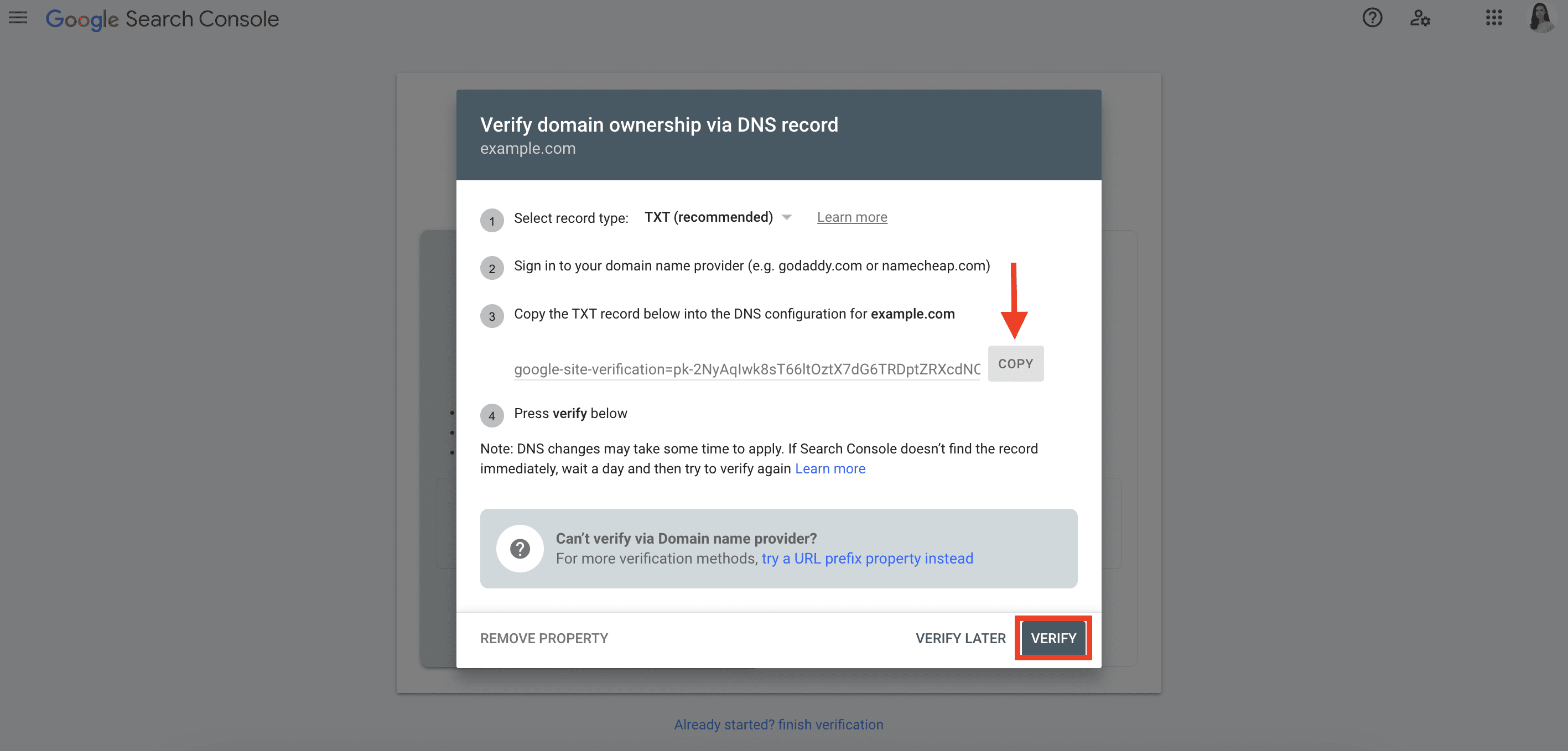
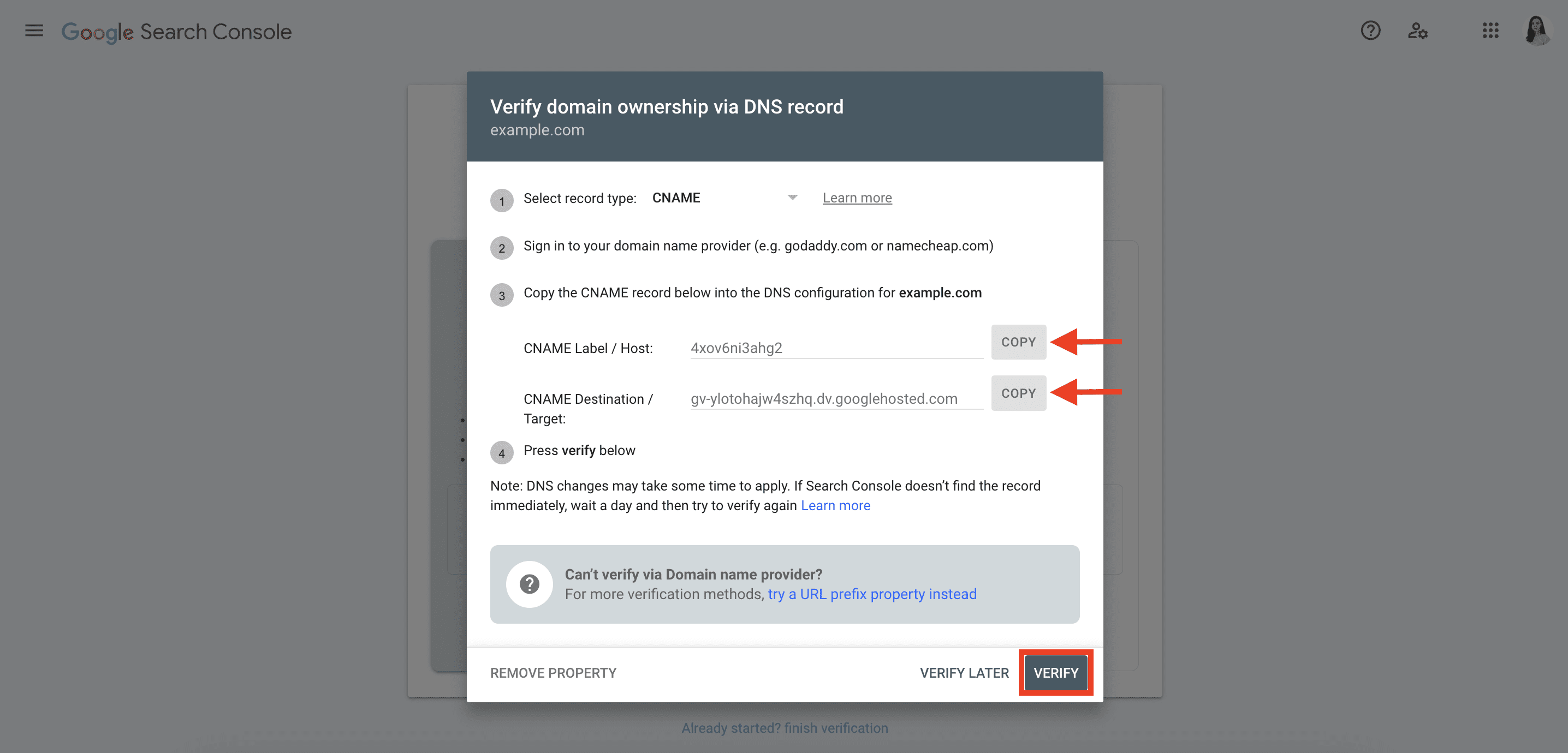
Note that your provider will need up to two or three days to start serving the record.
If you don’t know what your domain host is, take a look at the Google instructions on how to find your domain host. After identifying the DNS provider, choose it in the drop-down list, or select Any DNS provider.
URL-prefix property in Search Console
URL-prefix property supports four Google Search Console verification methods: HTML file upload, Meta tag, Google Analytics, and Google tag manager. This property type lets users analyze individual subsections of a website in Google Search Console. For example, if your site contains subfolders covering Germany and France, consider creating separate accounts for them:
- https://www.website.com/
- https://www.website.com/germany/
- https://www.website.com/france/
You also have to add a separate property for http and https protocols:
- http://www.website.com/
- https://www.website.com/
Also, include a separate property for each subdomain:
- http://m.website.com/
- http://website.com
- http://www.website.com
We’ll go over how to configure your Google Search Console setup for URL-Prefix properties later on in this article.
Google-hosted property
If you created your website with Google Sites, created a blog with Blogger, or used Google Domains, you can create either a Domain or URL-prefix property. You must be logged in with the same account you use to manage your Google-hosted website. This will ensure that your website can be automatically verified.
If the authentication process doesn’t happen automatically, you’ll need to follow specific instructions based on the property type you selected. Here are some rules to keep in mind:
- Select the Google Analytics Tracking Code method for Google Sites created after 2017.
- Use the HTML tag method for Google Sites or older blogs created before 2017.
Getting your website verified
Now that we have covered the steps for domain and Google-hosted properties, let’s figure out how other verification methods work. We have provided detailed step-by-step instructions for each scenario below.
HTML tag
To set up Google Search Console by adding a meta tag, you need to do the following:
- Select the URL Prefix property type and add your website URL.
- If HTML tag doesn’t appear as a recommended method, go to Other Verification Methods and select the HTML tag option.
- Copy the provided meta tag. It will be unique and tied to a specific user.
- Paste it into your website’s home page head tag (the page must be accessible to non-logged-in users) before the </head> tag, as shown in this example:
<head> <title>examplesite.com homepage</title> <meta name="google-site-verification" content="paste your meta tag here" /> </head>
- The meta tag should be included within the first 2MB of the HTML file. External resources like scripts are not included in the size calculation.
- Click Verify in Search Console.
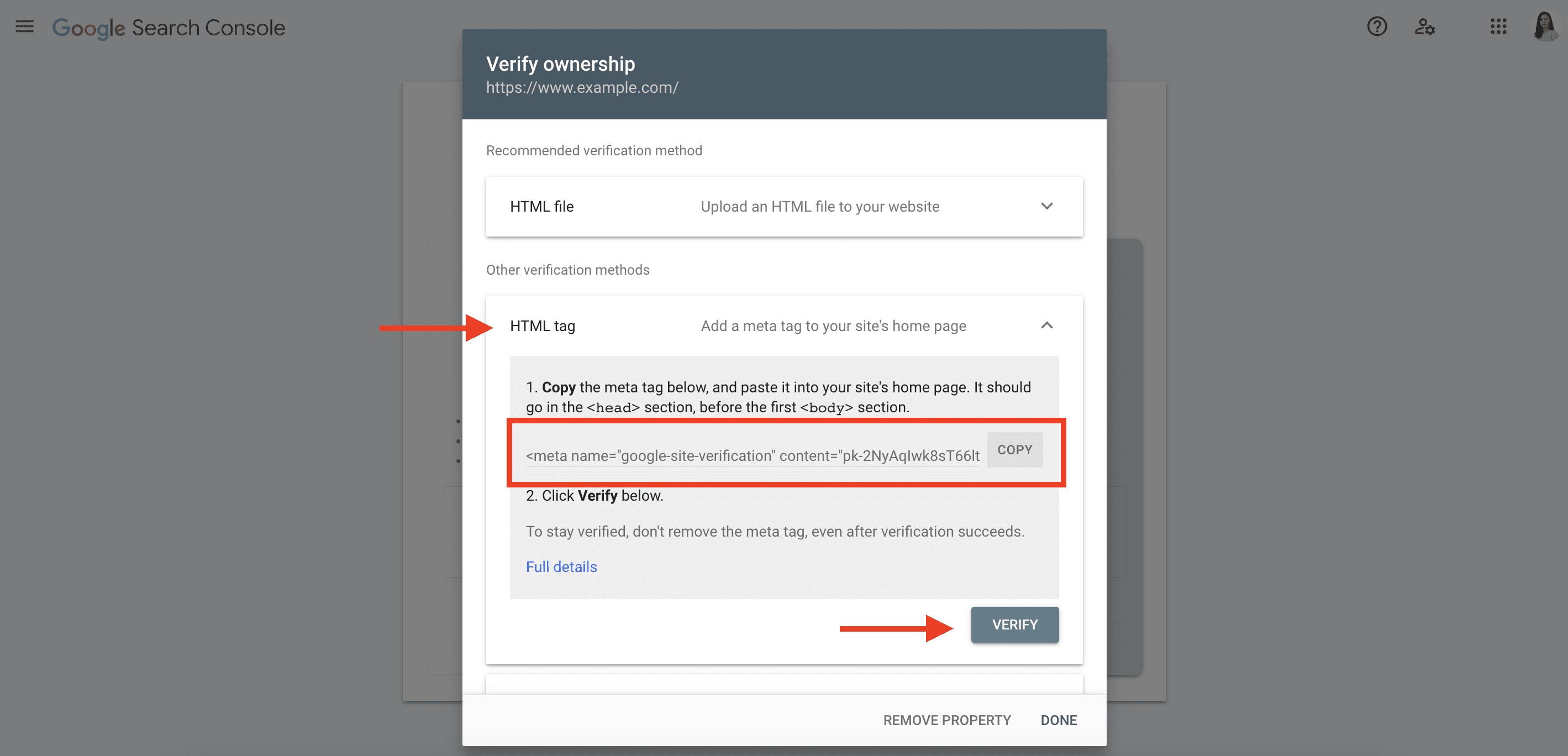
Ensure that the meta tag is present on your live page. Visit your website’s home page and inspect the page source text to locate the meta tag. Check that the tag is copied and pasted exactly as provided.
GSC will analyze whether the meta tag exists on that page. If it is missing or any other error occurs, you’ll get a notification with detailed information about the error. The system will also periodically check if the tag is still present on the page. If it is removed, you’ll be required to repeat the verification process.
Please note that only users with permission to edit the site’s source code can add the meta tag. You should choose a different method if you don’t have the necessary permission. If you’re using a website hosting platform, refer to their help guides for specific instructions.
HTML file
To prove your website ownership by uploading an HTML file, add your website URL in the URL Prefix property field exactly as it appears in the browser’s address bar.
Next, follow these steps:
- Expand the HTML section.
- Download the provided file.
- Upload it (exactly as it is) to the root directory, which is the topmost folder containing all files that make up your website.
- Click Verify in your Google Search Console account.
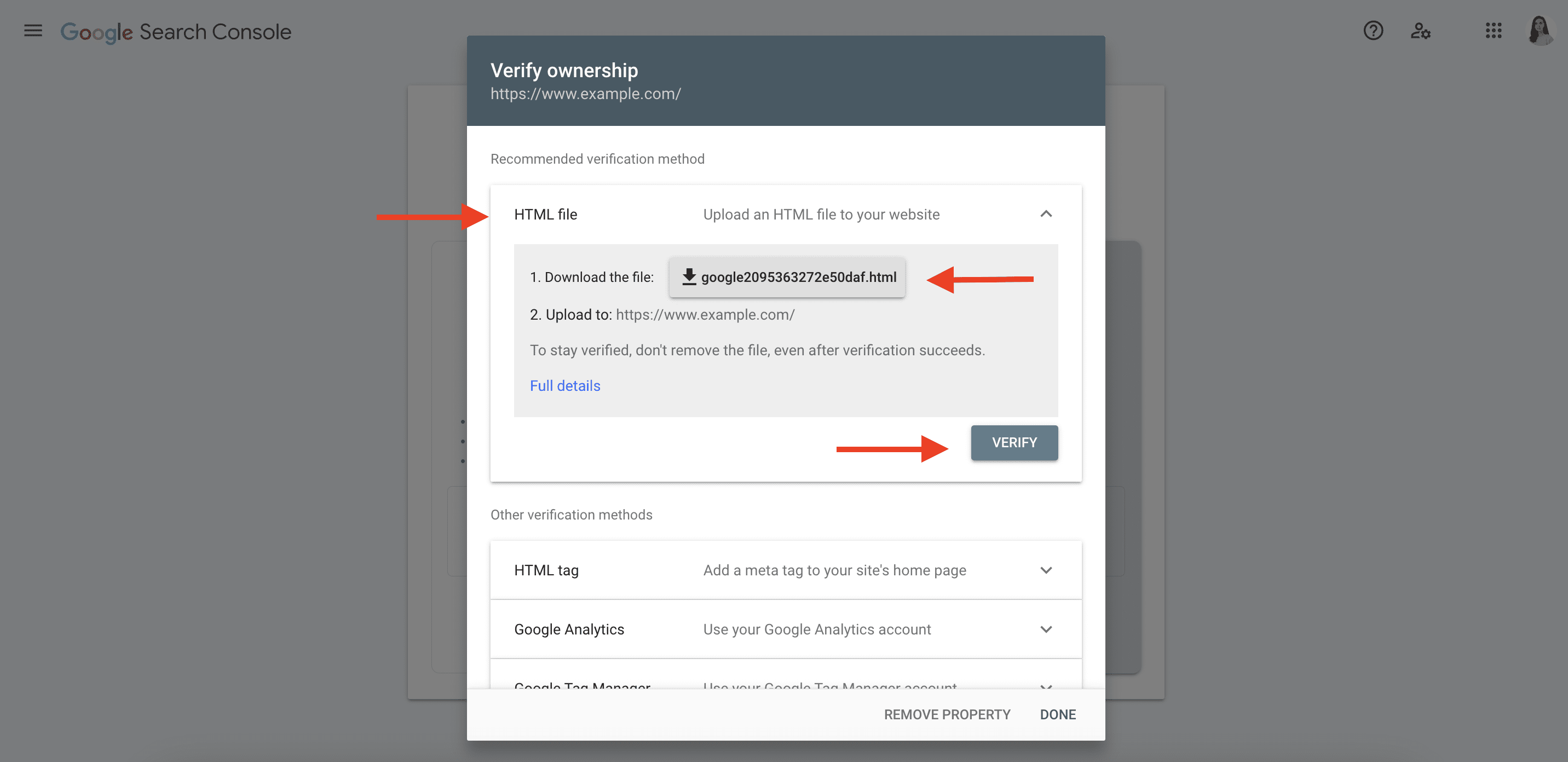
Here are some important considerations when using the HTML file method:
- The location where you upload the HTML file must be accessible to users who are not logged in. To confirm this, open the file in an incognito window to verify its accessibility.
- Ensure that you have the necessary access and permission to add files to the chosen location. If not, consider another option.
- Your website hosting platform might have custom requirements, so check its help pages before proceeding.
- If you remove the HTML file, you’ll lose verification.
- You can add more lines to the file after the main body, but avoid changing the file name or altering the main content.
- The HTML file is personalized for a specific user.
Google Analytics tracking code
This method can be used when you have access to both Google Search Console and Google Analytics accounts, and you are using the same Google account to manage both of them.
Here’s how to accomplish this:
- Make sure that you have at least editing permission in your Google Analytics account.
- Remember that the code in earlier versions of Google Analytics was connected to a Google Analytics Web Property. Because of the recent migration to GA4, the code is now connected to a Google Analytics stream.
- Check that your home page doesn’t require users to log in and that it has the analytics.js or gtag.js snippet. Please note that GSC only supports the latest version of the Google Analytics snippet. If you have an older snippet that contains either _gat. or _getTracker|urchin.js, you must update it to the latest version.
- Confirm that the Google Analytics tracking code is located in the head section of your homepage. If the code is placed in the body section or elsewhere, this method will not work. Avoid making changes inside the tracking code itself.
- Ensure the presence of the code by opening the page in the web browser, access the page source, and search for the specified snippet.
- The tag size must not exceed 2 MB (scripts aren’t counted).
After all preparatory steps have been completed, the next steps are pretty simple:
- Log in to Search Console with the account you use for Google Analytics.
- Click Add Property, enter your website URL, and choose the Google Analytics section.
- Select Google Analytics as your verification method.
- Click on Verify.
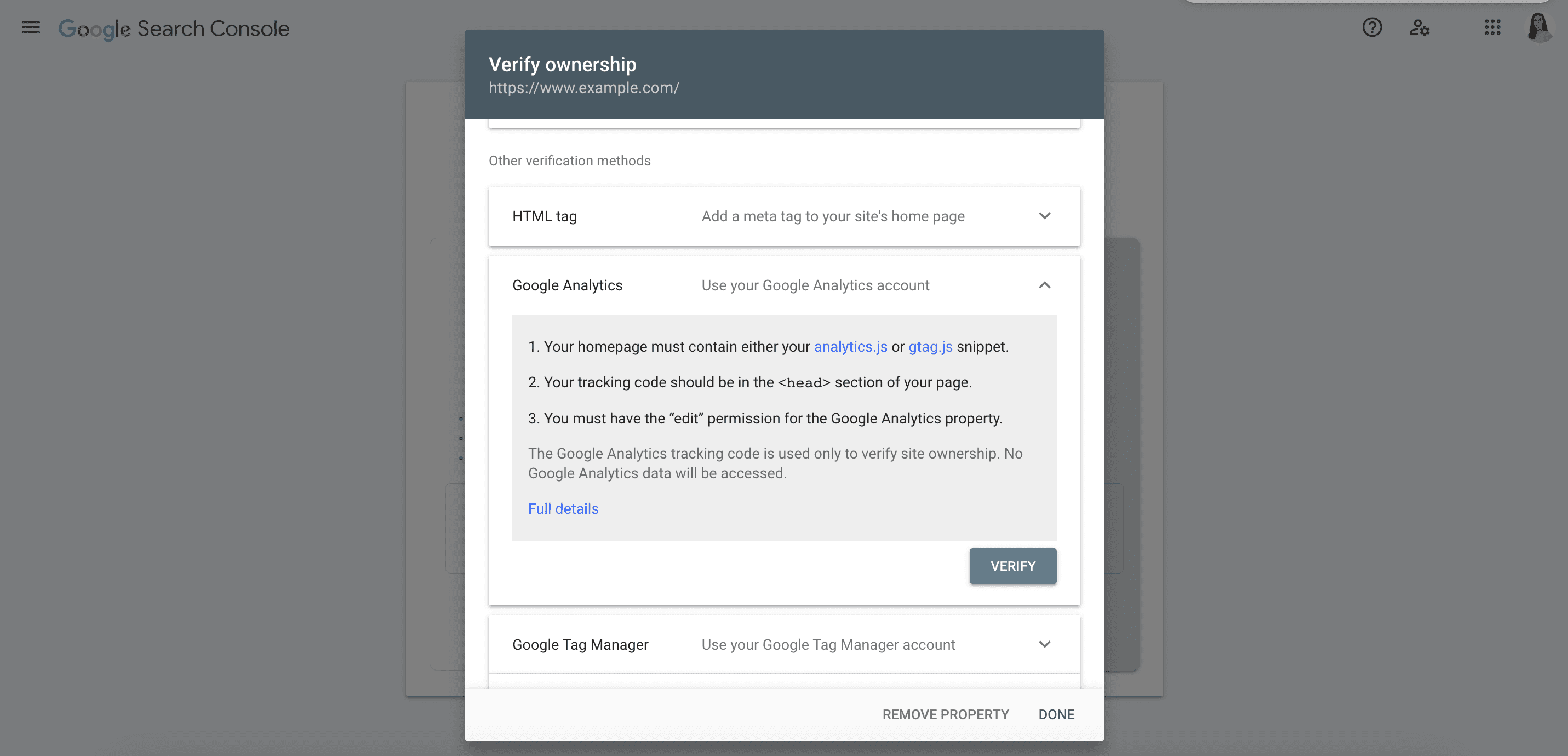
If you do everything right, it will be verified immediately.
Google Tag Manager container snippet code
You can also use the Google Tag Manager container snippet to submit your site to Google Search Console. If you haven’t created one yet, simply follow these instructions.
Before proceeding with GSC authentication, you will need to conduct some preparatory activities:
- Make sure that you have Publish or Admin permission to your container.
- Log in to the Search Console using the same account that you use for Google Tag Manager.
- Check that non-logged-in users can access your home page.
- The Tag Manager code must be on the home page immediately after the opening <body> tag. It’s crucial to avoid inserting any content between the <body> tag and the Tag Manager code.
- Don’t change the code, as any changes may invalidate it.
- View the required page source to confirm the presence of the code.
Now you can get back to GSC and continue the process:
- Click Add Property, enter your website URL.
- Choose the Google Tag Manager section.
- Click on the Verify button.
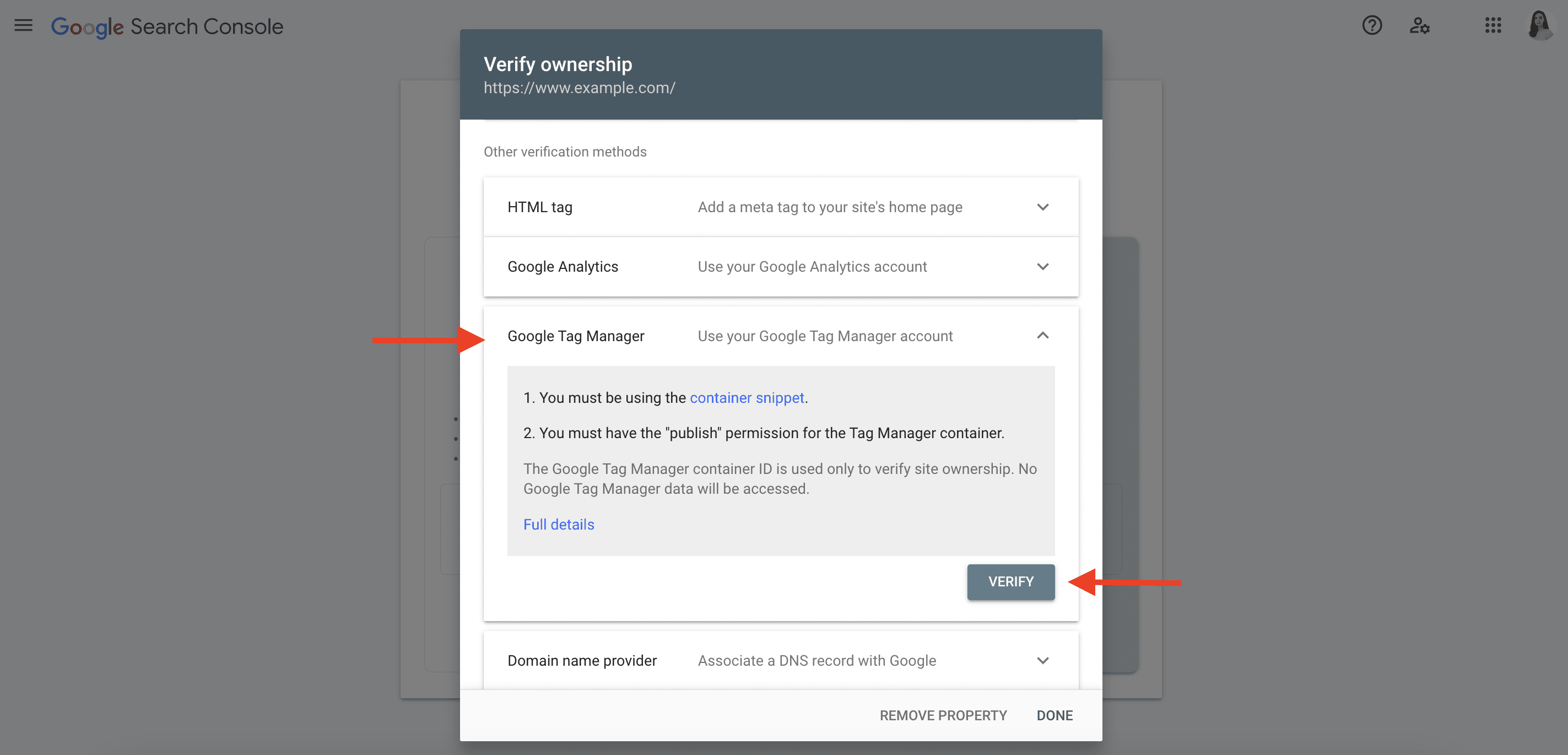
Common verification errors
Here are some common verification errors you may encounter and how to address them:
- Mistakes in tags, snippets, files
This error occurs when you make unauthorized changes to tags, code fragments, or files, rendering them invalid for verification. Ensure that you use the exact tag, code snippet, or file you received.
- Your file, tag, or code wasn’t found in the required location or was found in the wrong location
This can happen when the files, tags, snippets, or codes are not placed correctly according to the chosen verification method. For example, GSC won’t verify your website if your HTML file isn’t in the root folder of your property or if the HTML tag isn’t in the <head> section of the page. Follow location requirements precisely.
- Server timeout
If there is a server timeout, GSC may be unable to verify your file, tag, code, or snippet. This can happen when the server is temporarily down or responding slowly. Ensure that your server operates well and try again.
- DNS lookup error
A DNS issue can prevent GSC from accessing your file. This could indicate problems with your server or DNS routing. Double-check that your domain is resolving correctly before attempting again.
- Excessive redirection
GSC won’t follow redirects to another domain but can handle redirects within the same domain. Still, the process may fail if the download request is redirected multiple times or caught in a loop. Check the URL for any redirection problems that may hinder the process.
- Invalid server response
If your site requires password authentication or GSC is unable to access it for any other reason, it can result in an invalid server response during verification. Ensure that the location where you place your file or tag is accessible to non-logged-in users.
- Domain not found
GSC tried to resolve the provided site URL but failed because it was unknown to the DNS service. Double-check that you have entered the correct URL for your property.
How to add users and manage permissions
The next step in setting up a Google Search Console account is managing access to your projects. After signing in to GSC and confirming that you are a property owner, you will be able to grant permissions to other users.
Here are the user role permissions:
- Owner: Has access to all Console features and can grant permissions to other users.
- Full users: Can view any data and perform certain actions.
- Restricted users: Can view most data.
- Associate: Can view specific data or perform some actions, but not in the Console. Level of access depends on the type of association, such as being a channel on YouTube.
The owner must take the following steps to add a user to Search Console:
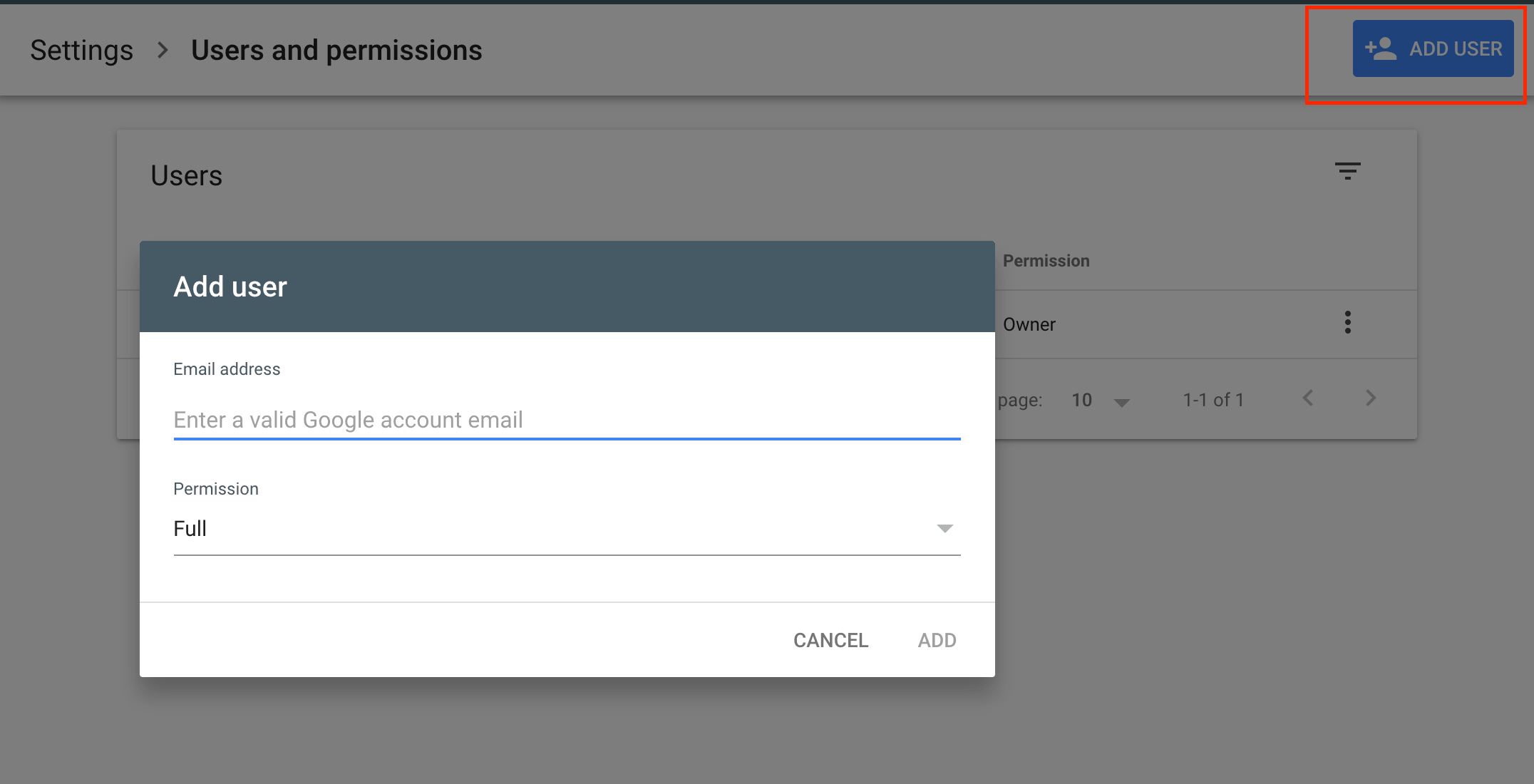
- Choose the property.
- Go to Settings, click Users and permissions.
- Select Add user, enter the user’s email and choose the permission type.
Here are the steps the owner must take to delete a user:
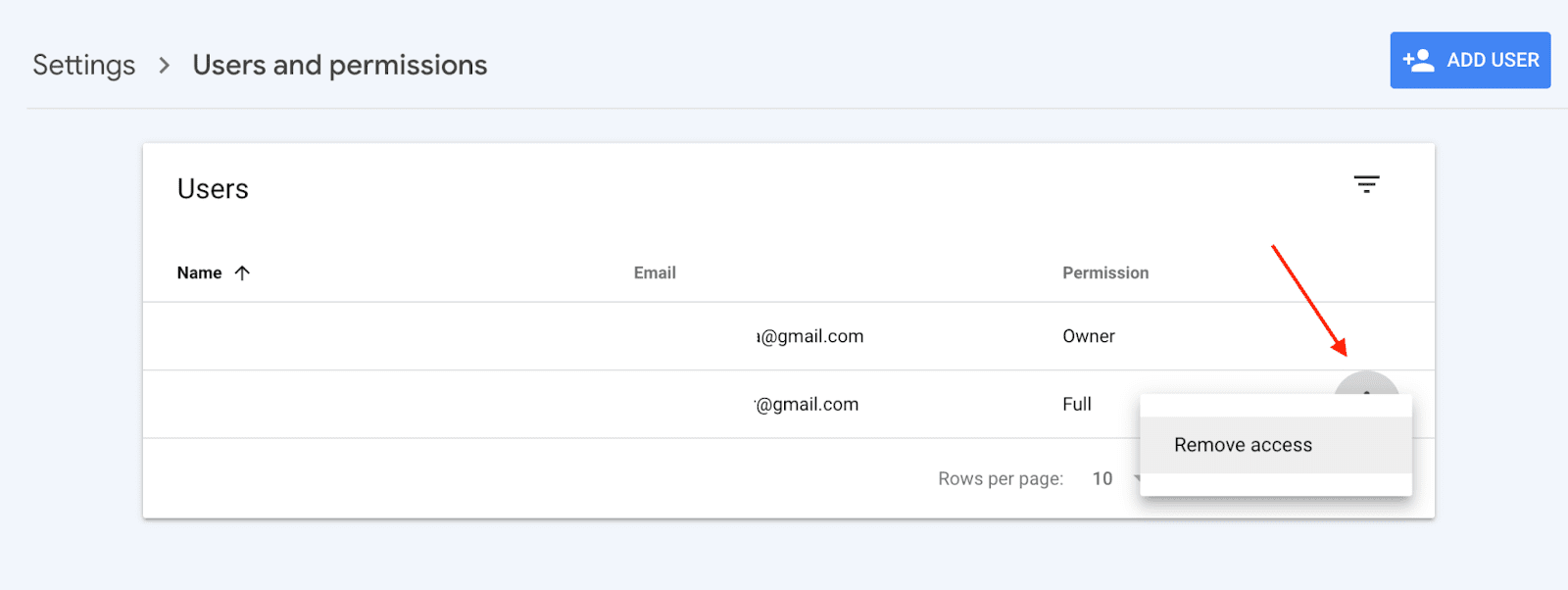
- Choose property.
- Go to Settings, click Users and permissions.
- Go to the three dots menu near the user’s name and choose Remove access.
You can also see the GSC account’s ownership history. This includes:
- All users that were added or removed.
- Successful and unsuccessful attempts to prove website ownership.
- Events when a previously known validation token has been deleted.
To access this feature, go to Settings, open the Users and Permissions tab, and click on Ownership History.
How to remove or resubmit a property
Owners and users have different abilities to remove properties in GSC. Owners can delete properties from anyone’s list, whereas users can only remove properties from their own lists.
To remove a property from your list, go to the property settings and click on Remove Property.
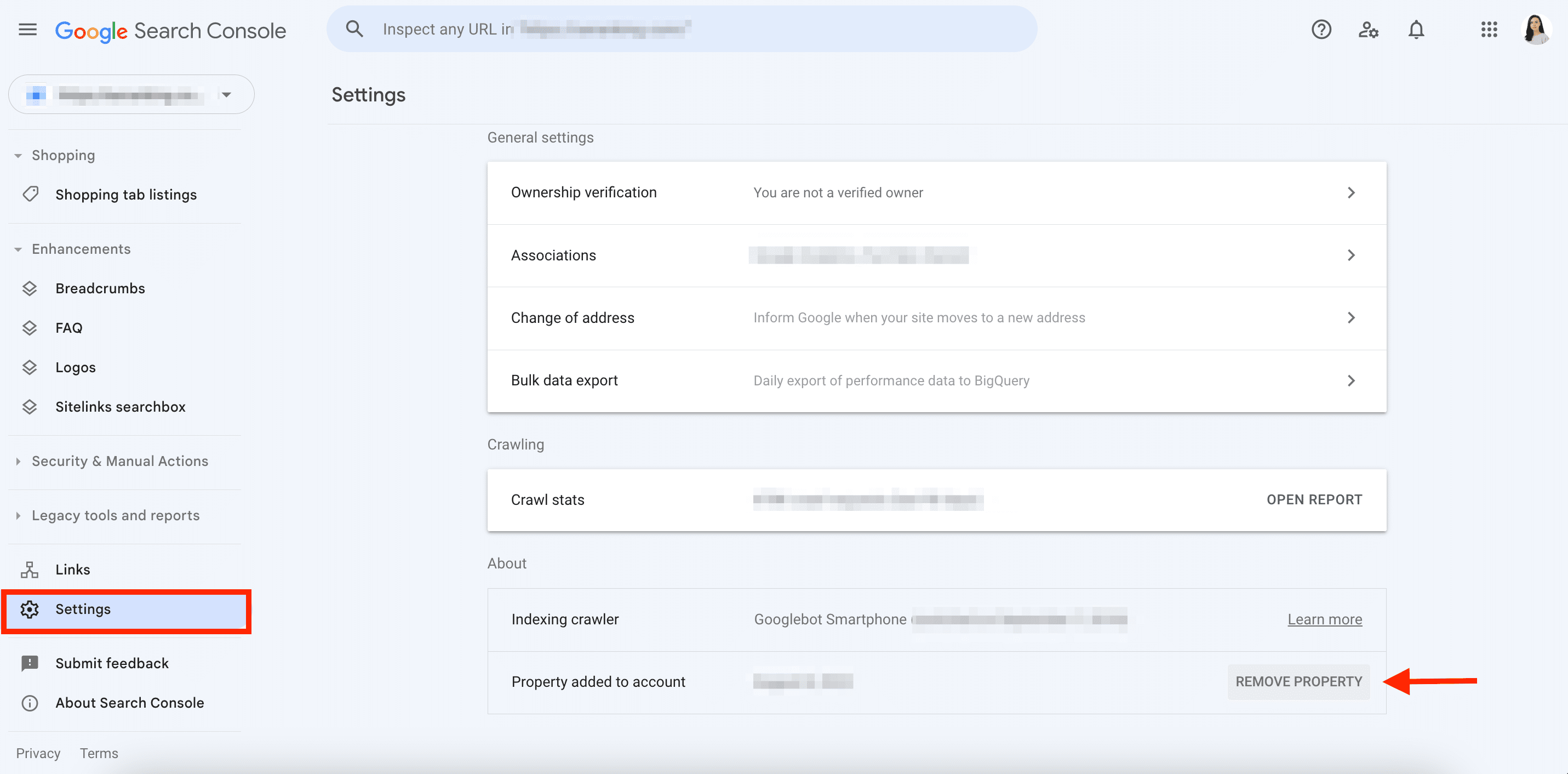
When removing access from another user, follow the procedure described in the previous section. But if one owner needs to terminate another owner’s access, they must also remove that owner’s access token (HTML file, meta tag, etc.). After deleting an owner, you’ll see all tokens for that person listed in the popup, and you should delete all of them to prevent access from being reinstated once Google detects them.
Removing a property means:
- You will no longe receive notifications for that property.
- You will not be able to see any information or access setting about that property.
- Your message history for that property will be saved.
- If you’re the last verified property owner, removing the property will result in all property users losing access to it in GSC.
If you need to re-add a removed property, you can do so without verification as long as the property still has one verified owner. Simply add the property as described in the previous section, and it will be automatically revalidated.
Additional GSC settings
GSC provides additional settings and tools to help you get the most out of its service and features. You can export data in bulk, associate your GSC account with another Google service, and inform Google about any changes made to your website’s address. We’ll cover this in more detail below.
Change of address
If you are migrating your site from one domain to another, you need to add the new site to GSC and follow the steps outlined in this article to verify your ownership.
When a website undergoes a domain change, it’s crucial to inform search engines about the new domain so that they can update their indexes accordingly. You can accomplish this using the Change of Address tool.
Access it from Settings and follow the instructions provided.
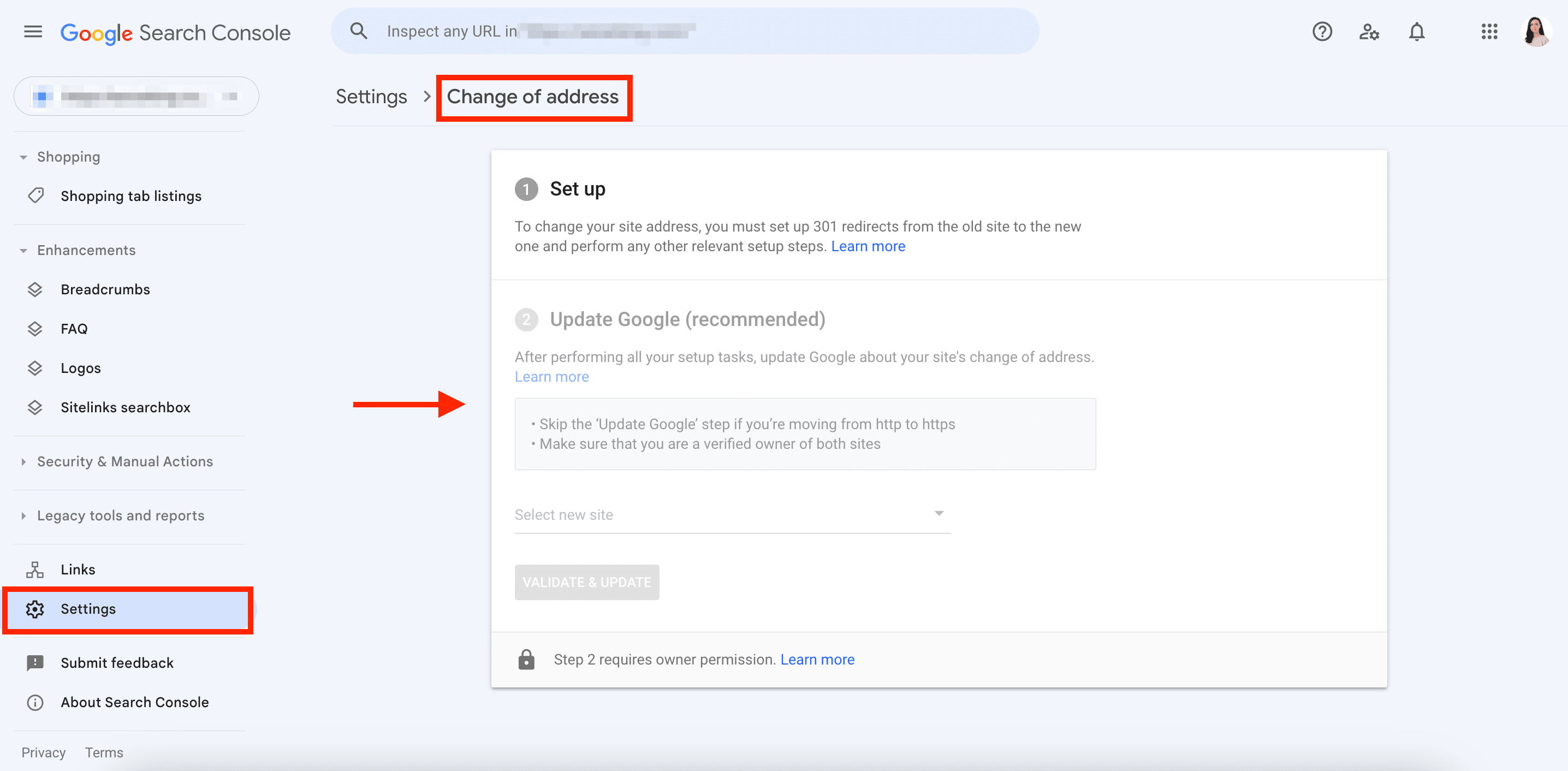
To use this feature:
- You must own old and new addresses.
- Verify both domain-level-properties.
- Ensure your website migration implies URL alterations.
Please note that the Change of Address tool cannot be used for migrating properties at the path leve, such as http://sitename.com/blog/.
The tool will automatically move your website’s protocols, but not the subdomains. You will have to move each subdomain separately.
Review the GSC verification of your new site and ensure that the new HTML file or code is correctly placed, or that the GA or Google Tag Manager container snippet is in the appropriate location.
Bulk data export
Bulk data export was released in February 2023 to help users continuously export data from GSC directly to Google BigQuery. The exportable data includes all your performance stats except for anonymized queries. You also won’t be limited to daily data row numbers. This allows you to research your data effectively and combine it with different data sources for deeper investigation.
You can access Bulk data export from Settings.
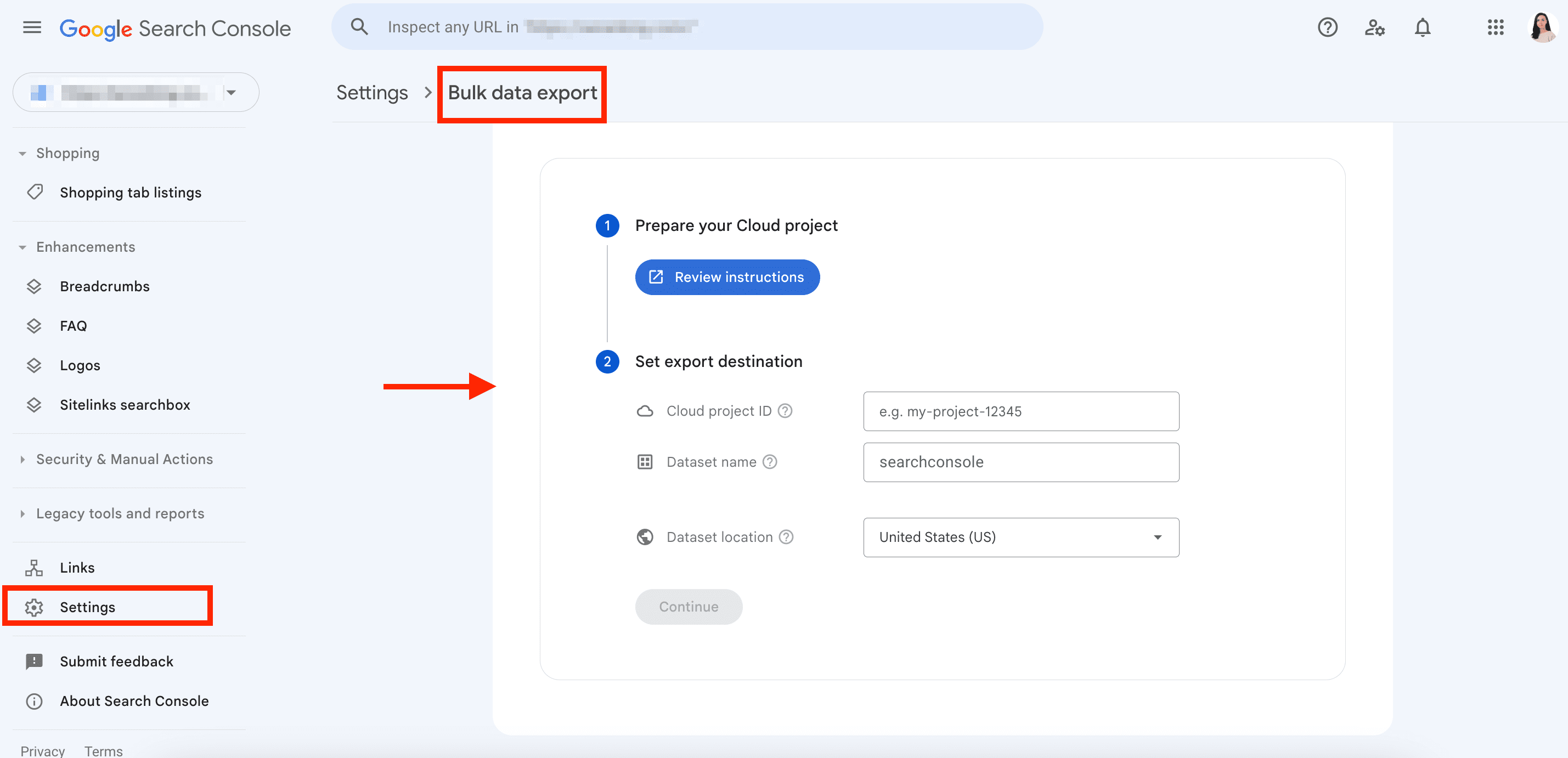
To activate this feature:
- Enable the BigQuery API for your project.
- Grant permission to your Search Console service account.
- Specify your Google Cloud project ID.
- Select a dataset location.
Associations
An association refers to linking a GSC property with a property in another Google service. This allows for data integration and insights across both tools. For example, you can connect your GSC and your Google Analytics to access combined data in GSC Insights.
The following properties can be associated with GSC:
- Google Analytics
- Chrome Web Store
- Android Play Store app
- Play Console Developer
- Google Ads
- Google Assistant Actions Console
To view existing associations, go to Settings and choose Associations. Here, you will find a list of connected services and pending requests. To remove an association, click on the three dots next to it and remove it.
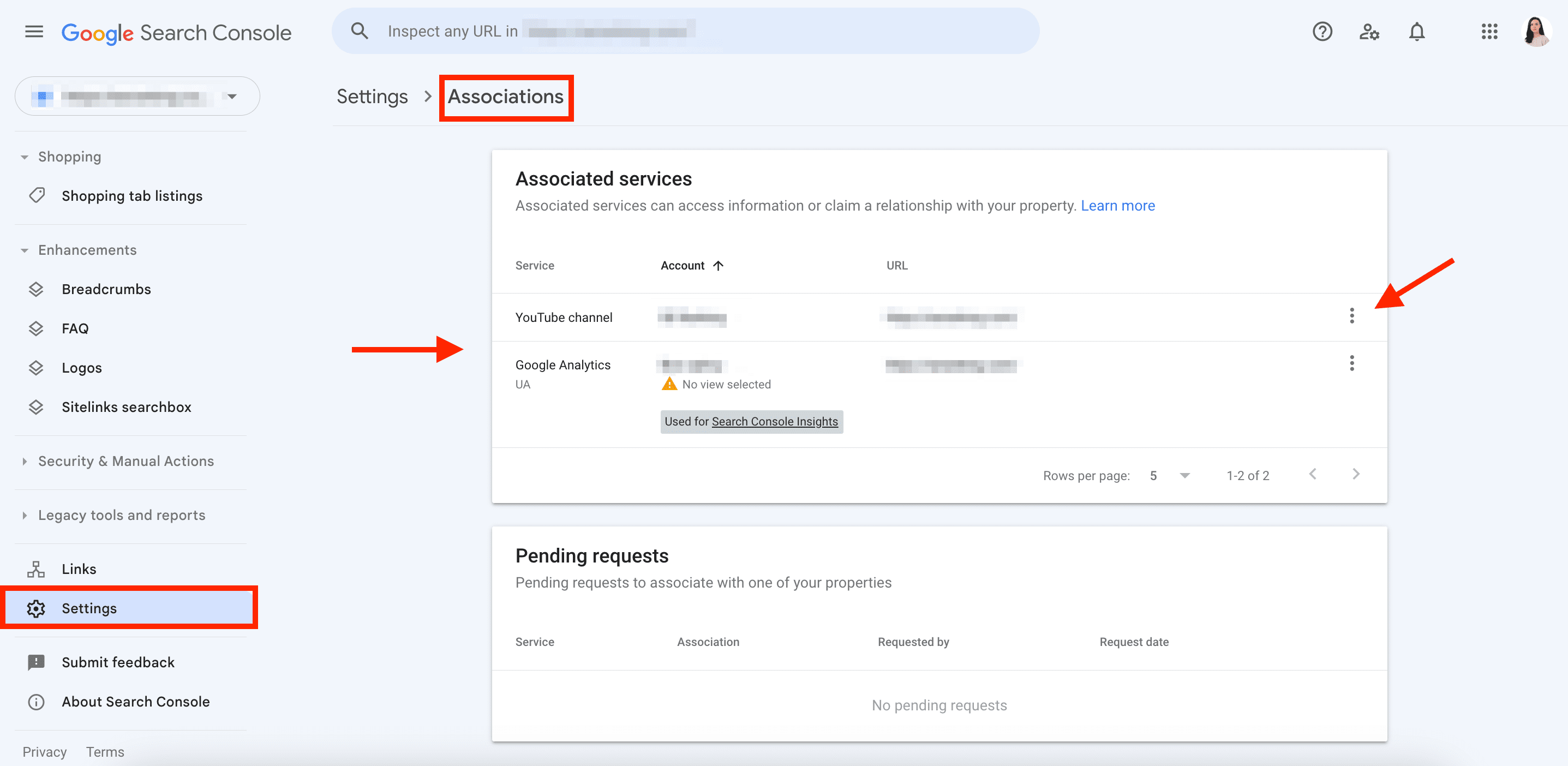
Associations with GA can be established from within GSC, while associations with other services need to be initiated from the respective product.
How to connect Google Search Console to different Content Management Systems
Here we will guide you on how to connect Google Search Console to your site based on theCMS you are using. Some CMSs are more SEO-friendly than others right out of the box. For detailed information about the benefits and limitation of popular CMSs, consult our guide on the best CMS for SEO.
If you have a WordPress, Shopify or Wix site, you can easily verify it in GSC to optimize for SEO. Follow the simple steps provided for all three of these popular CMSs.
Add your WordPress site to Google Search Console
To verify a WordPress site in Google Search Console, you have to download an HTML file. Please follow the instructions for verifying ownership by uploading an HTML file. You can add the file directly to the header.php file above the <body> tag or use aspecific plugin called Insert Headers and Footers for this purpose.
If you have the Yoast plugin installed, you can connect Search Console to your website. Here’s how to do it:
- Copy a meta tag using the method of Verifying your ownership by adding a tag to your site.
- Log in to your WordPress site.
- Select SEO > General > click on the Webmaster Tools tab.
- Paste the Google code and save the changes.
- Go to Google Search Console and click Verify.
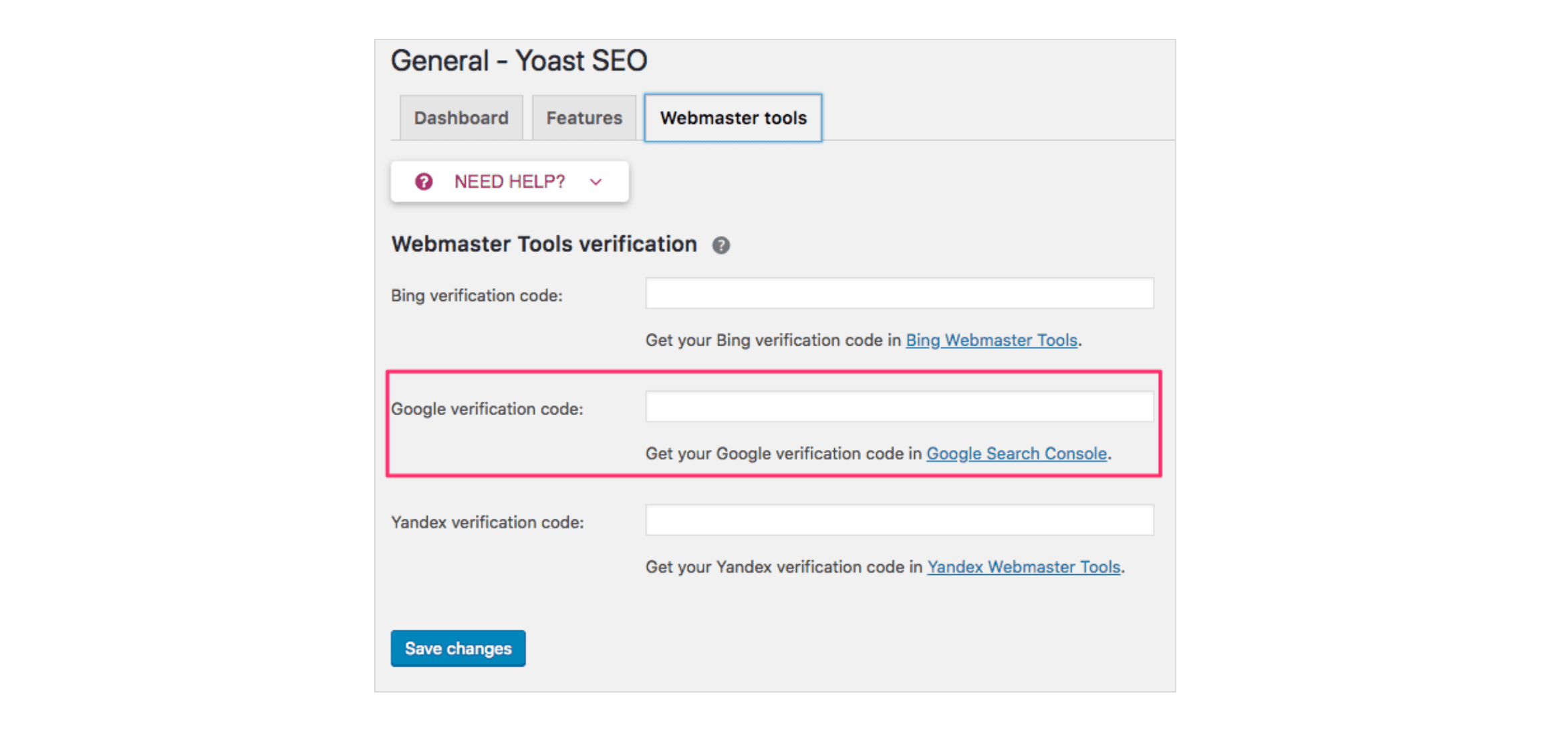
Google Search Console and Shopify
To connect Google Search Console and Shopify, you can use the HTML meta tag. To retrieve the tag, please see the instructions above. Paste the code into your Shopify theme after logging in to the Shopify store. To do this, click Online Stores > Themes > Action > Edit Code. Choose theme.liquid in the Layout folder. Search for the closing <head> tag in the code editor and paste the HTML code right above it. Then hit Save.
Finally, go back to Google Search Console and click Verify.
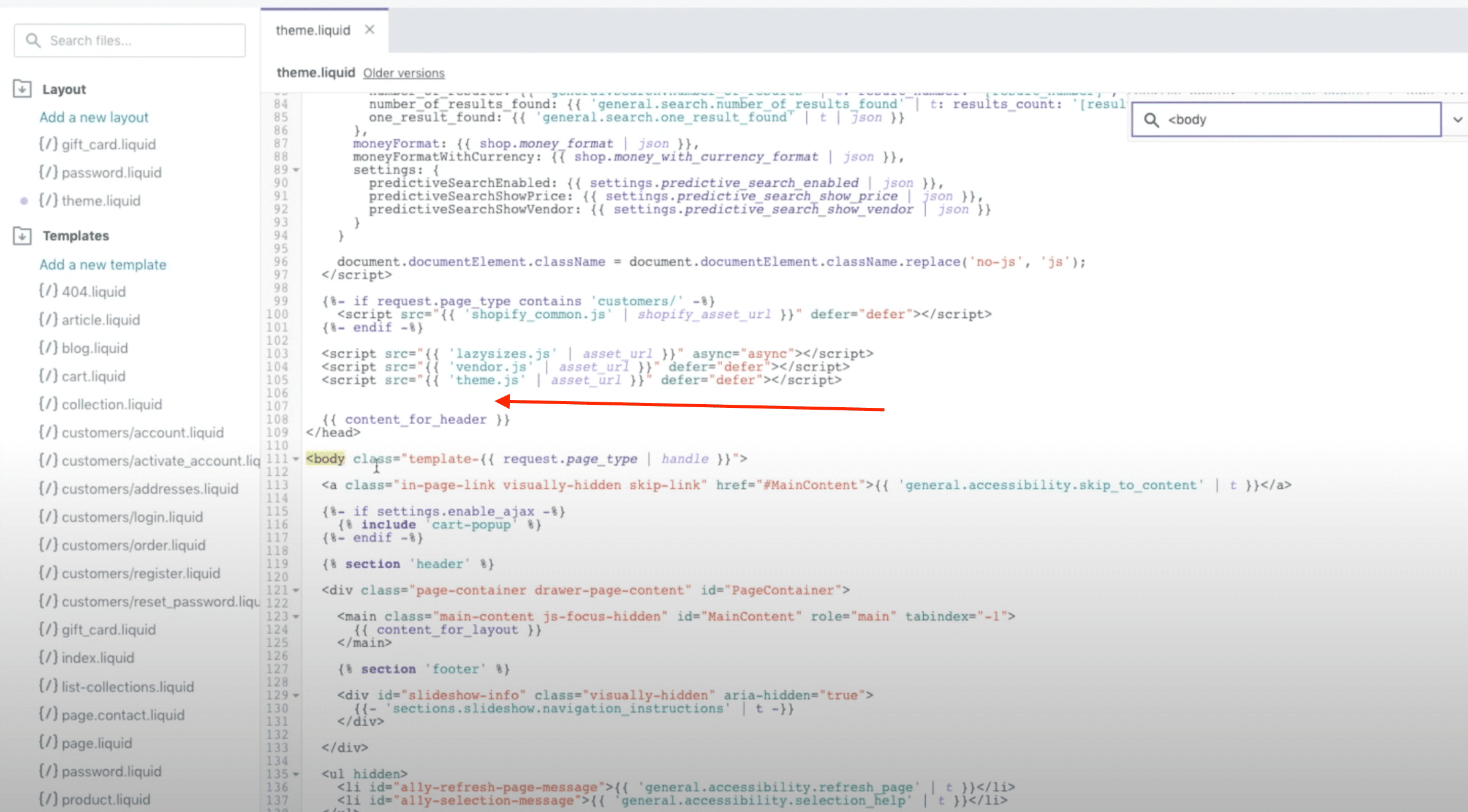
Connect Wix to Google Search Console
If you are using Wix, you can connectit to GSC by retrieving a meta tag following the instructions mentioned earlier.
To add your tag to the Wix site:
- Go to your Wix dashboard and click SEO Tools.
- Choose Site Verification.
- Click on Google Search Console.
- Insert the meta tag and click Save.
Adding several domains to one Google Search Console account
Users can add up to 1000 properties to their GSC account, but whether they should or shouldn’t is a topic of debate among webmasters. While most agree that owners can add multiple domains to their accounts without affecting SEO, search engines may not favor the use of non-standard SEO techniques. It would be wiser to keep your main projects separate and segment your websites instead of adding them to a single account.
But if you run official projects, such as working for multiple customers as an SEO specialist or running an agency, it can be more convenient to add multiple properties within a single account.
It’s also worth noting that Google doesn’t penalize you for adding multiple properties to a single account.
How to connect your Google Search Console account to SE Ranking?
Connecting Google Search Console to SE Ranking provides you with a full view of your site’s GSC Performance through its Search Results report. All of this information is neatly displayed on a single user interface, with no need to swipe between screens.
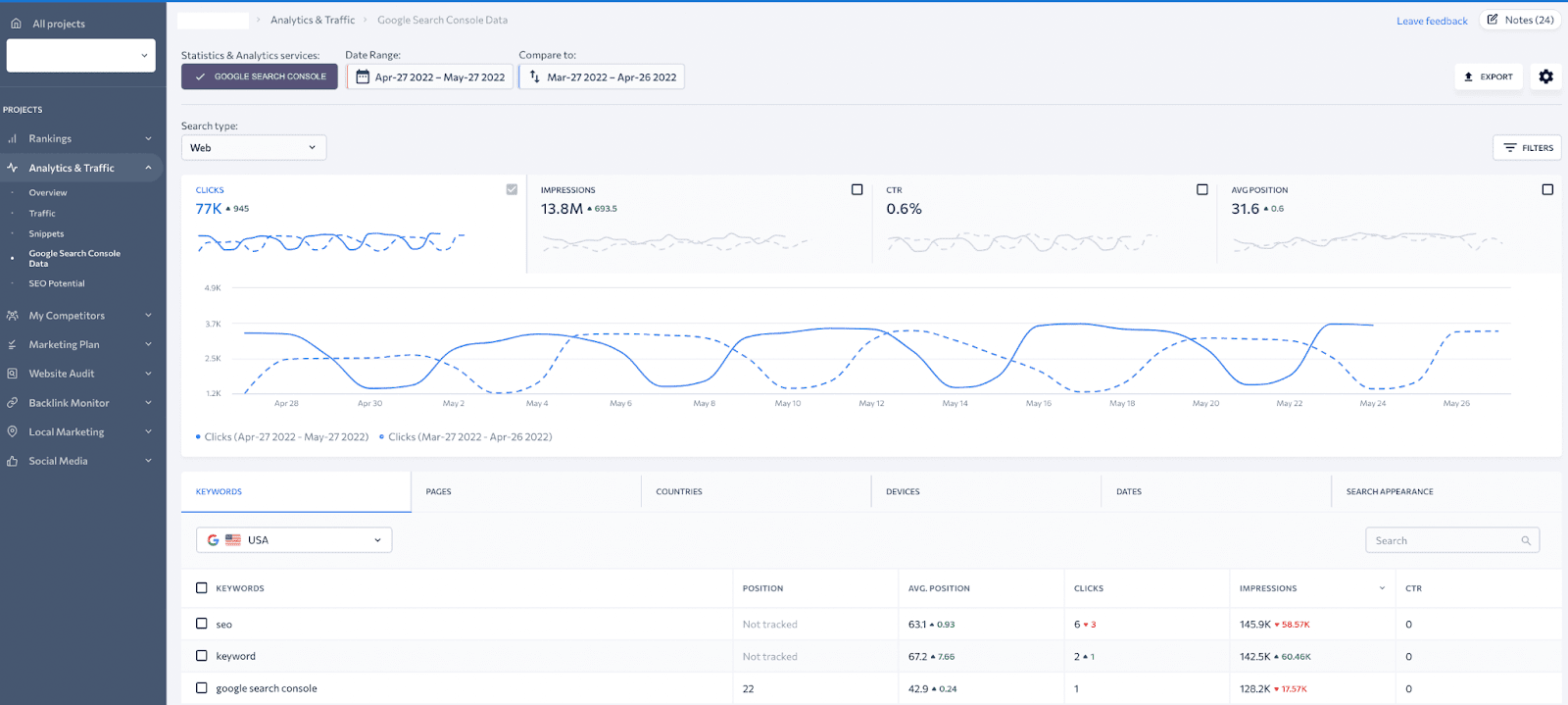
The report displays a list of keywords, each of which you can analyze and filter according to its ranking position, clicks, impressions, and click through rate (CTR). Apart from the average keyword position displayed by GSC, you can also access the latest data from SE Ranking. Unlike GSC, which typically takes a couple of days to display complete data for a specific date, SE Ranking offers you more precise updates on the same day.
By using this tool, you can not only expand your keyword database but also perform a ranking check to identify keywords that you currently rank for but are not on your target list.
Once identified, you can add them to your project and track their rankings. But make sure to carefully analyze and distribute these keywords across your website to avoid keyword cannibalization.

When you connect GSC to your project in SE Ranking, you can also view clicks in the Detailed tab under Rank Tracker. The clicks column in the keyword table shows the number of clicks your website received in Google search results for specific keywords. This data is retrieved from GSC for the last 30 days.
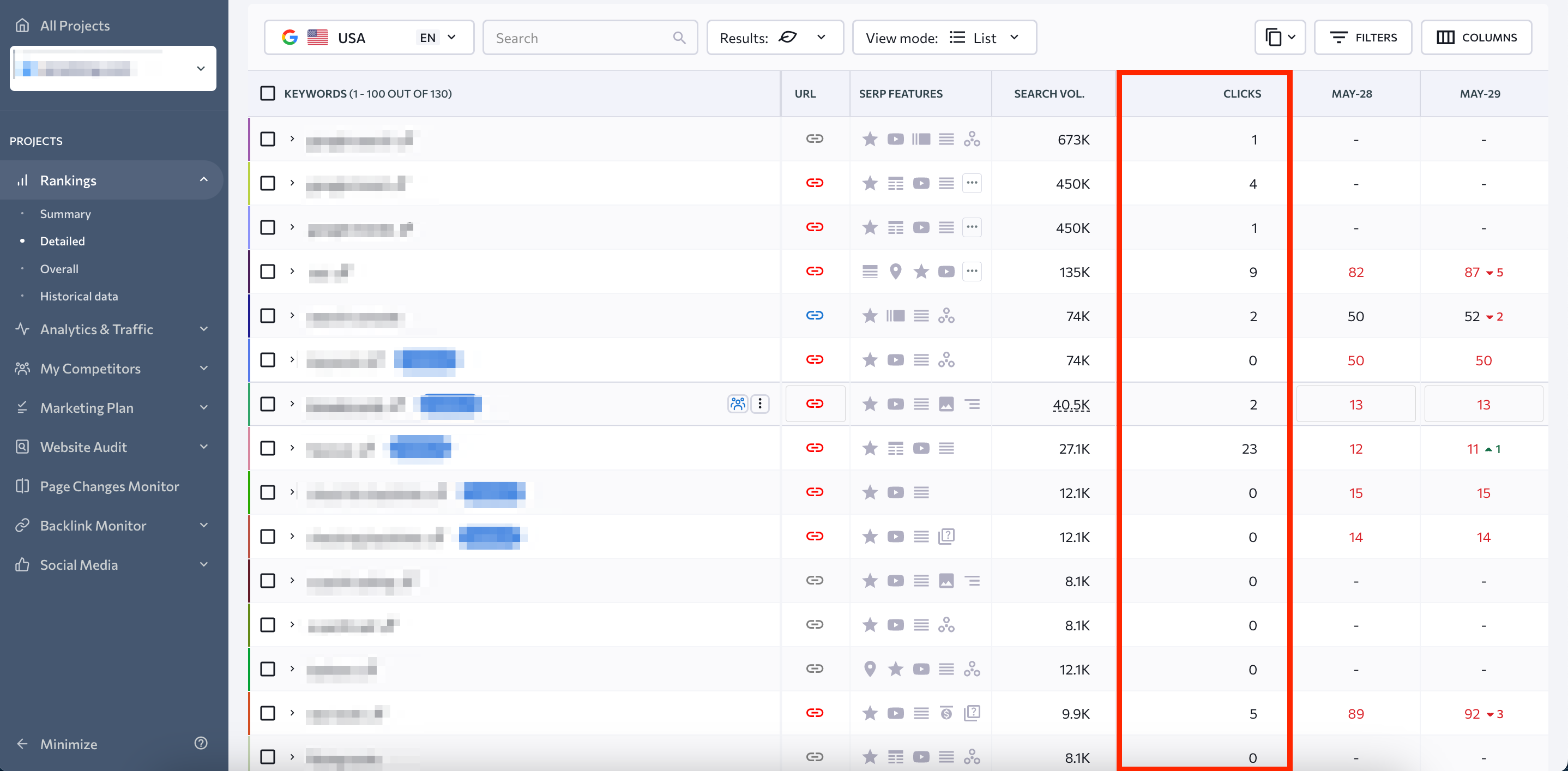
To connect GSC to SE Ranking, simply log in to your Google account that is linked to GSC. Click on Connect Google Search Console and select the desired property.
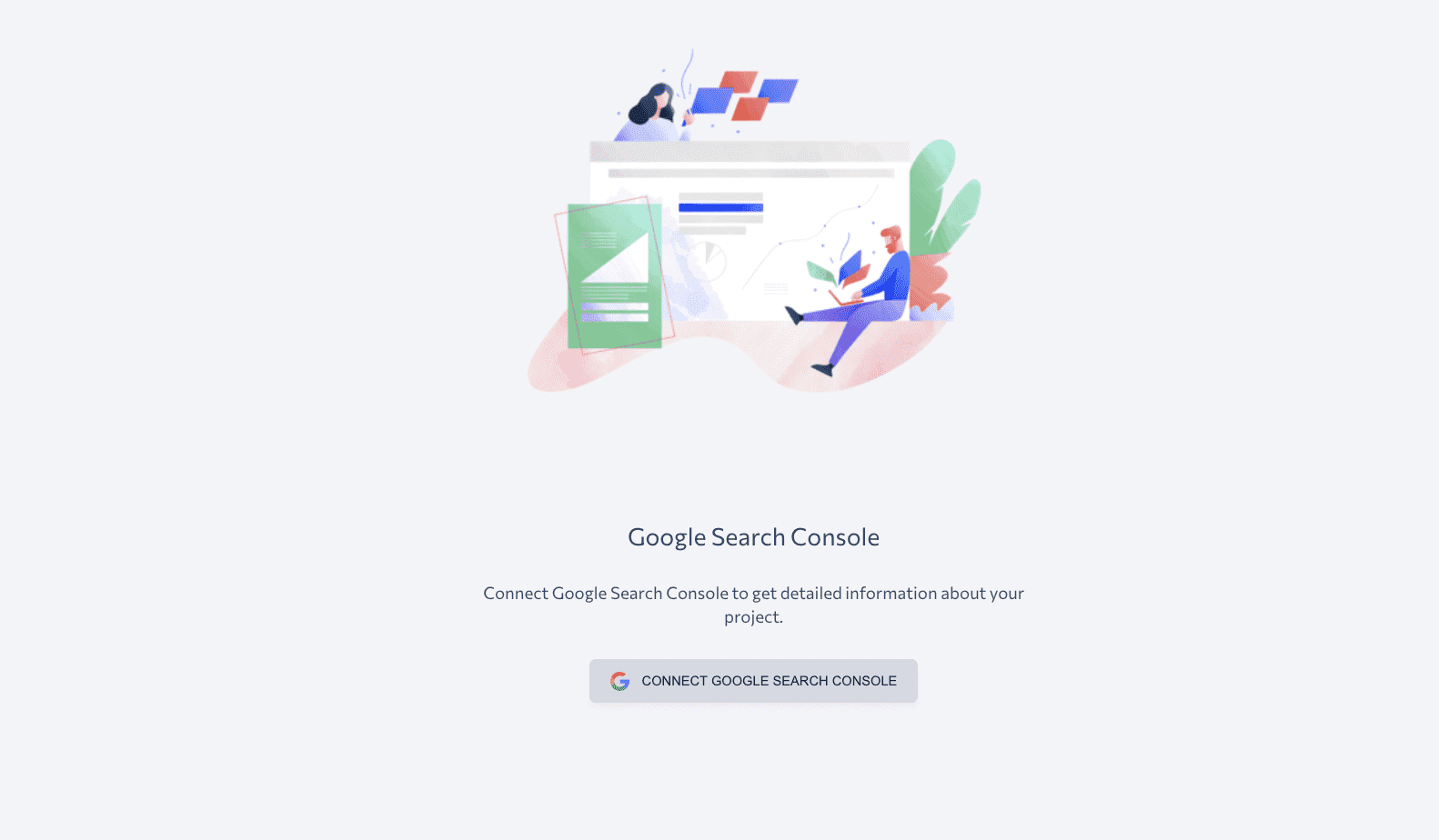
Once connected, you will have access to all GSC data on your SE Ranking dashboard. Here are some of the actions you can take with this integration:
- Choose a specific date range and analyze the data for that period.
- Compare data between two selected periods to identify trends and changes.
- Analyze metrics such as clicks, impressions, CTR, and position of the site, specific pages, or queries in the search results.
- Filter the data by six different criteria, including search type, device type, country, search appearance, query, and URL.

